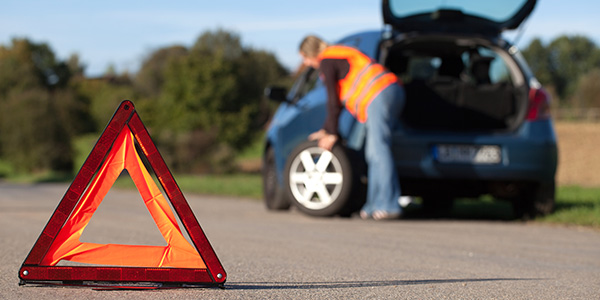You are driving your car and all of sudden — blam! The car begins shaking, the steering wheel becomes difficult to control and you’re frantically looking for a way to pull over to the shoulder. What you just experienced is a tire blowout or complete tire failure, with your tire destroyed because of some sort of impact or perhaps a tire problem.
If you experience a blowout, you’ll need to take immediate action to get your car and everyone in it to safety. Blowouts can lead to an accident, something that may be avoided if you take certain precautions.
How to Handle a Blowout
A blowout typically occurs without warning. Often, a blowout happens when you’re speeding down the road and you hear a loud pop. It may sound like someone hit your car with mortar. In any case you’ll find yourself fighting with the steering wheel to get off the road.
If you do experience a blowout, tire experts encourage you to avoid braking, at least at first. It is important that you maintain acceleration, even increasing it slightly to move the car out of traffic. Always avoid swerving into another lane. You need to maintain your composure and control the steering wheel.
It is also important that you steer in the opposite direction of where the car is being pulled. For instance, if one of the right sided tires has a blow out, then steer to the left. The goal here is to maintain forward momentum as well as control over your vehicle. As soon as possible, move to the side of the road (shoulder) or pull into a parking lot.
Tire Blowout Basics
Tires may blow out without warning. If you hit a sharp object in the road, then your tire may experience immediate and catastrophic failure. Such a situation may be entirely unavoidable, especially if you don’t see the object until after you pass over it.
Blowouts can also occur if you load your vehicle beyond its payload capacity. For instance, if you have a midsize sedan with a payload capacity of 1,200 pounds, then that could mean too much pressure on the tires. Five people weighing 200 pounds each means 1,000 pounds of payload. Add in the 200 pounds of stuff in the trunk and another 200 pounds in the roof rack and you’re hauling 1,400 pounds or 200 pounds more than what your car is intended to hold. Couple that with not enough air pressure in your tires and no wonder your tires blew!
Tires can also blow out if they are not carefully maintained. It is important that you regularly observe your tires to ensure that there is enough tread, that blistering and cracking are not present, and that there is no signs of bubbling. Anything out of the ordinary can lead to extraordinary failure — putting you and others in danger, especially if the car loses control.
Tire Replacement Time
No one wants to experience catastrophic tire failure and that is why proper tire maintenance is essential. Rotate your tires on a regular basis according to your owner’s manual. When there isn’t enough tread left, then replace your tires advises Mavis discount tires.
If you need to replace your tires, always replace them in pairs or as a set. If you are replacing in pairs, then the new tires are always placed to the rear axle. Next, move the best of your old tires to the front axle.
Replacing all four tires at once can be most beneficial, especially from a price savings standpoint. Typically, tire stores will give you a discount when buying four tires. In some cases the tire manufacturer will provide four tires for the price of three. Don’t forget to check your spare too as it is the tire you will turn to when an emergency happens.


